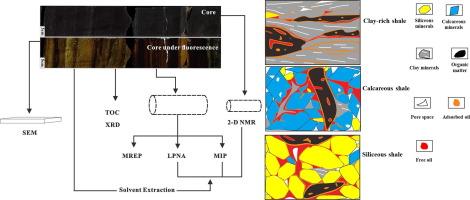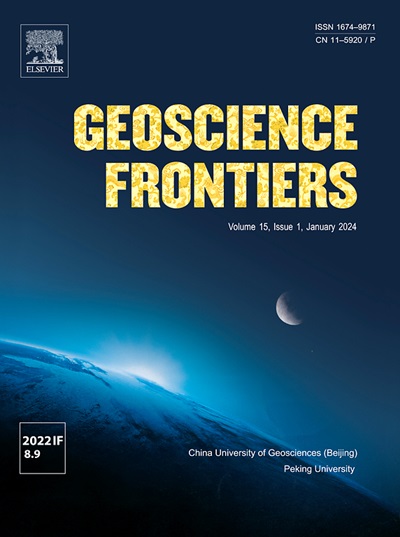Shale oil occurrence and mobility mechanisms in brittle mineral-enriched reservoirs: Insights from the Paleogene Kongdian Formation, Bohai Bay Basin
IF 8.9
1区 地球科学
Q1 GEOSCIENCES, MULTIDISCIPLINARY
引用次数: 0
Abstract
Understanding shale oil occurrence and mobility is essential for evaluating resource potential and optimizing exploration in lacustrine shale systems. This study investigates the Paleogene Kongdian Formation in the Bohai Bay Basin, integrating organic geochemistry, mineralogical analysis, scanning electron microscopy, solvent extraction, multi-step Rock-Eval pyrolysis, and 2-D NMR to characterize shale oil occurrence states and mobility mechanisms in brittle mineral-enriched reservoirs. Results indicate that shale oil mainly occurs in free and adsorbed states within interparticle pores, dissolution pores, microfractures, and organic pores, with most retained oil hosted in nanopores smaller than 200 nm. Quantitative analyses show that siliceous and calcareous shales possess higher movable oil ratios than clay-rich counterparts, primarily due to their rigid mineral frameworks that resist compaction and preserve interparticle and intragranular pores. These brittle-rich lithofacies exhibit broader pore size distributions, enhanced connectivity, and reduced adsorption affinity, facilitating more efficient oil accumulation and displacement. In contrast, micropore-dominated, clay-rich shales exhibit strong adsorption and limited pore continuity, which hinder hydrocarbon mobility. Appropriate TOC levels (2.0–4.5 wt.%) favor shale oil mobility, while excessive organic content increases adsorption, reducing the proportion of free oil.
Among various geological factors, brittle mineral content and thermal maturity play the dominant roles in controlling shale oil mobility, as they fundamentally shape pore structure and fluid properties. In combination with organic matter abundance and sedimentary features, these factors jointly govern pore network evolution and hydrocarbon occurrence states, thereby determining shale oil enrichment and extractability. These findings enhance the understanding of shale oil enrichment processes and provide a scientific basis for identifying sweet spots and optimizing development strategies in lacustrine shale reservoirs.

渤海湾盆地古近系孔店组页岩油赋存状态及运移机制
了解页岩油的赋存状态和活动性对于评价湖相页岩系统的资源潜力和优化勘探至关重要。以渤海湾盆地古近系孔店组为研究对象,综合运用有机地球化学、矿物学分析、扫描电镜、溶剂萃取、多步岩石热解、二维核磁共振等方法,对脆性富矿储层页岩油赋存状态及运移机制进行了表征。结果表明,页岩油主要以颗粒间孔隙、溶蚀孔隙、微裂缝和有机孔隙中的游离态和吸附态赋存,大部分滞留在小于200 nm的纳米孔中。定量分析表明,硅质和钙质页岩比富含粘土的页岩具有更高的可动油比,这主要是因为它们具有坚硬的矿物框架,可以抵抗压实作用,并保留颗粒间和粒内孔隙。这些富含脆性的岩相具有更宽的孔径分布、更强的连通性和更低的吸附亲和力,有利于更有效的油气聚集和驱油。而以微孔为主、富含粘土的页岩则表现出较强的吸附作用和有限的孔隙连续性,阻碍了油气的运移。适当的TOC含量(2.0-4.5 wt.%)有利于页岩油的流动性,而过高的有机含量会增加吸附,降低游离油的比例。在各种地质因素中,脆性矿物含量和热成熟度对页岩油运移起主导作用,它们从根本上决定了孔隙结构和流体性质。这些因素结合有机质丰度和沉积特征,共同控制孔隙网络演化和油气赋存状态,从而决定页岩油的富集和可采性。这些研究结果增强了对页岩油富集过程的认识,为识别湖相页岩储层甜点和优化开发策略提供了科学依据。
本文章由计算机程序翻译,如有差异,请以英文原文为准。
求助全文
约1分钟内获得全文
求助全文
来源期刊

Geoscience frontiers
Earth and Planetary Sciences-General Earth and Planetary Sciences
CiteScore
17.80
自引率
3.40%
发文量
147
审稿时长
35 days
期刊介绍:
Geoscience Frontiers (GSF) is the Journal of China University of Geosciences (Beijing) and Peking University. It publishes peer-reviewed research articles and reviews in interdisciplinary fields of Earth and Planetary Sciences. GSF covers various research areas including petrology and geochemistry, lithospheric architecture and mantle dynamics, global tectonics, economic geology and fuel exploration, geophysics, stratigraphy and paleontology, environmental and engineering geology, astrogeology, and the nexus of resources-energy-emissions-climate under Sustainable Development Goals. The journal aims to bridge innovative, provocative, and challenging concepts and models in these fields, providing insights on correlations and evolution.
 求助内容:
求助内容: 应助结果提醒方式:
应助结果提醒方式:


